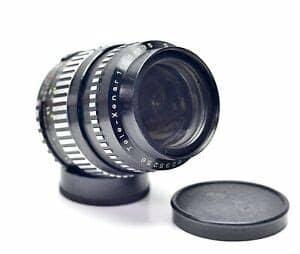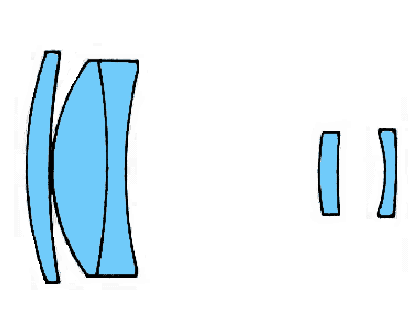The Lens details of a series of images taken by Steve Cushing on mirrorless camera.
Fitting is a 42mm mount with a 45.46mm
Flange Distance - this lens will fit and achieve focus to infinity mirrorless cameras and on DSLRs.
History
Schneider-Kreuznach is the abbreviated version so they name is actually longer still it was made by Jos. Schneider Optische Werke GmbH. They are a manufacturer of industrial and photographic optics. The company was founded on 18 January 1913 by Joseph Schneider as Optische Anstalt Jos. Schneider & Co. at Bad Kreuznach in Germany. The company changed its name to Jos. Schneider & Co., Optische Werke, Kreuznach in 1922, and to the current Jos. Schneider Optische Werke GmbH in 1998.
In 2001, Schneider received an Oscar for Technical Achievement for their Super-Cinelux motion picture lenses. It is best known as manufacturers of large format lenses for view cameras, enlarger lenses, and photographic loupes. It also makes a limited amount of small- and medium-format lenses, and has at various times manufactured eyeglasses and camera rangefinders, as well as being an OEM lens maker for Kodak and Samsung digital cameras. It has supplied the lenses for various LG devices and the BlackBerry Priv. It also supplied the lenses for the Kodak Regent camera in the 1930s and other classic cameras such as certain models of the Rolleiflex starting in the 1940s, the Kodak Retina and Kodak Retinette camera series in the 1950s and 1960s, and certain specialty lenses for Hasselblad. In 1961, it created Feinwerktechnik GmbH, a manufacturer of electrical-hydraulic servo valves.
The history of German lenses mirrors German history and all of its highs and lows. World War I, the global financial crisis and World War II were years of ups and downs. From 1933 and through World War II many german manufacturers supported the Nazi regime as did most major German industries. When World War II began in September 1939 there was an air of invincibility in Germany, and in keeping with traditional practice, lens maker products proudly borne the makers trademark and city of origin of the product. Forced foreign labourers (Fremdarbeiter) were brought to work at manufacturing facilities.
In 1945 the U.S. Third Army advance, and on April 13 the regimental combat team 80th Division cleared Jena where they found the Carl Zeiss factory complex. It had sustained what they described as "surprisingly little effective bomb damage"
After the defeat of Nazi Germany in WWII, in compliance with the Yalta agreements the U.S.military forces departed. In June or early July the Russian military forces occupied Jena and the remainder of what became East Germany (German Democratic Republic). Russians 'appropriated' the original optical equipment and designs from Carl Zeiss factory in Jena. Carl Zeiss know-how was one of the most prized possessions of the post-war era and helped accelerate innovation in the USSR's optical industry, By one year later, the Russians had evacuated much of the remaining technical and management staff and about 92% of the Carl Zeiss Jena manufacturing facilities to the east. But the Russian fear of possible further conflict with the western allies rendered moving any production capability into a more defensible Russian province a sensible strategic step.
Most folk have heard of Zeiss which was founded in 1846 and is one of the most enduring manufacturers of anything mechanical anywhere in the world. Similarly they have heard of Leitz which is nearly as old with their Leica cameras and lenses as famous as any photography apparel. Voigtlander completes the pantheon of optics from Germany. But unknown to many there is a fourth German optics company that, whilst getting far less attention, is almost as old and just as important in German optics manufacturing. That company is Schneider-Kreuznach formed in 1913. Unlike Leica, Schneider-Kreuznach has been almost exclusively a lens manufacturer, and the cameras these lenses have fitted to are legendary and varied; Hasselblads, Rolleis, Kodak digital cameras, and more recently LG smartphones.
Schneider-Kreuznach lenses have gone to the moon, and they’ve won an Oscar for technical achievement.
This Lens1965 Schneider-Kreuznach Edixa-Tele-Xenar 135mm f/3.5
First things first, I’ll just call this lens the Schneider or SCH in my picture file names, since Schneider-Kreuznach Edixa-Tele-Xenar 135mm 3.5 is quite of a mouthful. The Schneider is a telephoto prime lens for 35 mm SLR cameras with the M42 screw mount.
Today the lens is rather expensive and popular. Its optical design is different from that of the analogous lens for the Rollei SL35 system, which is the later enhanced lens. Despite the fact, the M42 version is more appreciated because of a larger compatibility with modern cameras and is more expensive.
It consists of 5 elements in three groups.
The lens comes in three basic modifications different in appearance.
A thick "zebra", with massive ribbed rings - most common version, manufactured from about 1960 to 1965
The lens I have which has thin "zebra", plain rings - this is the rarest version, manufactured for a year from 1965 to 1966
An all black, artificial leather coated ring, manufactured from 1966 to the late 1970.
It is most likely that it is not only the lens' exterior that had been changing, the optical scheme had slightly changed as well. But the exact information is difficult to find now.
Lens in Use- It’s a beautiful made lens, sleek and solid, while still retaining a small package.
- The focus and aperture on the Schneider are well positioned and easy to grip. For a 135mm this lens isn’t that long and albeit on the heavy side, is a pretty compact little gem.
- Sharpness wise, I think it’s good, centre is sharp and corners catch up nicely by f8.
- Contrast is mediocre, I caught myself bumping it up a bit more than I usually do in processing.
- Vignetting is very noticeable wide-open and you have to stop down all the way to 5.6 to see good improvement.
- Some Chromatic Aberrations
Summary
This lens made my eyes open wide when I saw the results for the first time.
For general information on lens design and lens elements go to the homepage
HERE





